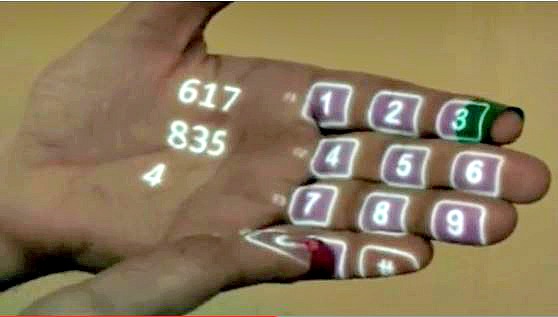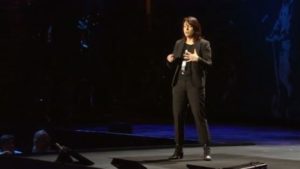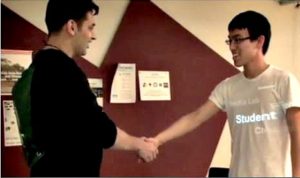The Big Idea: An inexpensive, wearable device (SixthSense) can interact with our environment to give us easy access to relevant information to help us make better decisions.
The overall construct of the speech: A demonstration, mostly via video. The demonstration was of a device that functioned somewhat like Google Glass, but which was worn like a necklace, made of off-the-shelf components: a webcam, a portable, battery-powered projection system and a mirror. The components communicated with a person’s cell phone, which acted as the communication and computation device.
Not perfect: This speech lacked many of the polished presentation aspects you might expect from a TED Talk.
This was apparent in the very first sentence, a long, somewhat confusing opening sentence: “I’ve been intrigued by this question of whether we could evolve or develop a sixth sense — a sense that would give us seamless access and easy access to meta-information or information that may exist somewhere that may be relevant to help us make the right decision about whatever it is that we’re coming across.”
Yikes. “Meta-information.” Pattie Maes tried to explain that term, which was helpful, but I found myself distracted by such academic jargon.
Her attempts at humor also fell a bit flat. For example: “When you meet someone here at TED — and this is the top networking place, of course, of the year — you don’t shake somebody’s hand and then say, ‘Can you hold on for a moment while I take out my phone and Google you?’” It’s a funny idea to imagine, but she didn’t play it up. She acted it out quite quickly, without any exaggeration of movement or facial expression (which would have made it funnier), and then she didn’t pause for people to imagine the silliness of it.
The ending was also quite abrupt. Pattie Maes again credited the PhD student, Pranav Mistry, who “was the genius” behind the device (and I kept wondering, “Well, then why isn’t he up there?”). But, on the positive side, she did end with stretching our imaginations even more “. . . maybe in another 10 years we’ll be here with the ultimate sixth sense brain implant.”
Clothing: Yeah, I’m going to mention what she was wearing. All black. Boring, especially with a dark blue background, with dark shadows and a black stage. Also since she was wearing the device, her black shirt made it harder to see.
What the speaker nailed: Not talking too much! This talk is only about 8.5 minutes long, and much of it is a video demonstration of what was a fascinating idea in 2009, when the talk was presented.
Some of the demonstrations:
- Telling time by drawing a watch on your arm.
- Taking pictures by making a rectangle with your fingers.
- Getting a word cloud on someone you just met with words from their blog and personal web pages.
With the example of the device creating a word cloud when you meet someone, she effectively circled back to her opening example of meeting someone and the awkwardness of asking them to wait while you googled them to get some information on them. Instead of that awkward exchange, the SixthSense device would project a word cloud about them.
Clearly the reason this speech was the ninth-most watched TED video is that it was a captivating idea, demonstrated clearly.
The biggest take-away: A unique idea, well-described or demonstrated, will captivate an audience.
Next week: David Gallo: Underwater Astonishments




2 Responses